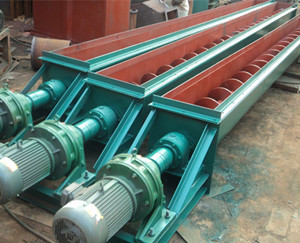


The working principle of a screw conveyor: When the screw shaft rotates, due to the gravity of the material and the frictional force generated with the groove wall, the material can only move forward along the groove bottom of the conveyor under the push of the blades. The situation is like a nut that cannot rotate moving in translation along a rotating screw. The movement of materials in the middle bearing relies on the thrust of the materials moving forward from behind. So, the transportation of materials in a conveyor is a sliding motion. In order to keep the screw shaft in a favorable tension state, the driving device and discharge port are generally placed at the same end of the conveyor, while the feed port is placed as close to the tail of the other end as possible. The rotating spiral blades push the material for transportation, and the force that prevents the material from rotating together with the spiral conveyor blades is the weight of the material itself and the frictional resistance of the spiral conveyor housing to the material. The surface shape of the blades varies depending on the type of material being conveyed, including solid surface, belt surface, and blade surface. The screw shaft of the screw conveyor has a thrust bearing at the end of the material movement direction to provide axial reaction force to the screw along with the material. When the machine is long, an intermediate suspension bearing should be added.
Spiral conveyor is a mechanical device that uses an electric motor to drive a spiral to rotate and push materials to achieve the purpose of conveying. It can be transported horizontally, obliquely or vertically, with the advantages of simple structure, small cross-sectional area, good sealing, easy operation, easy maintenance, and convenient enclosed transportation. Spiral conveyors are divided into two types in terms of conveying form: axial spiral conveyors and shaftless spiral conveyors. They are also divided into U-shaped spiral conveyors and tubular spiral conveyors in terms of appearance. Axial screw conveyor is suitable for non viscous dry powder materials and small particle materials (For example: cement, fly ash, lime, grain, etc.) and shaftless screw conveyors are suitable for conveying materials that are viscous and easily entangled. The working principle of a screw conveyor (such as sludge, biomass, garbage, etc.) is that the rotating screw blades push the material to be transported by the screw conveyor. The force that prevents the material from rotating together with the screw conveyor blades is the weight of the material itself and the frictional resistance of the screw conveyor housing to the material. The spiral blades welded on the rotating shaft of the screw conveyor have different surface types depending on the conveyed material, including solid surface type, belt surface type, and blade surface type. The screw shaft of the screw conveyor has a thrust bearing at the end of the material movement direction to provide axial reaction force to the screw along with the material. When the machine is long, an intermediate suspension bearing should be added.
